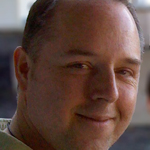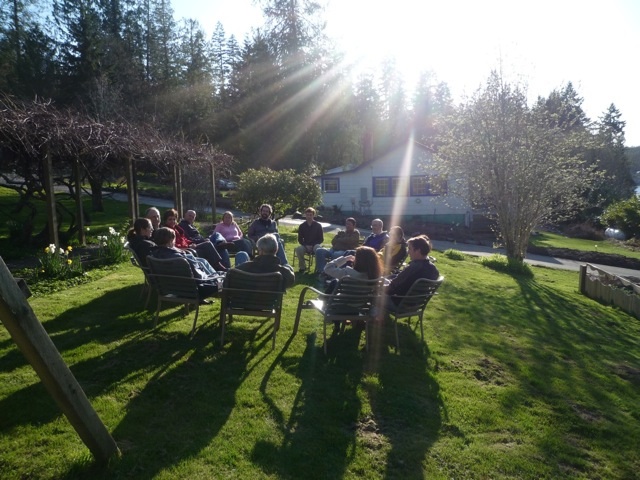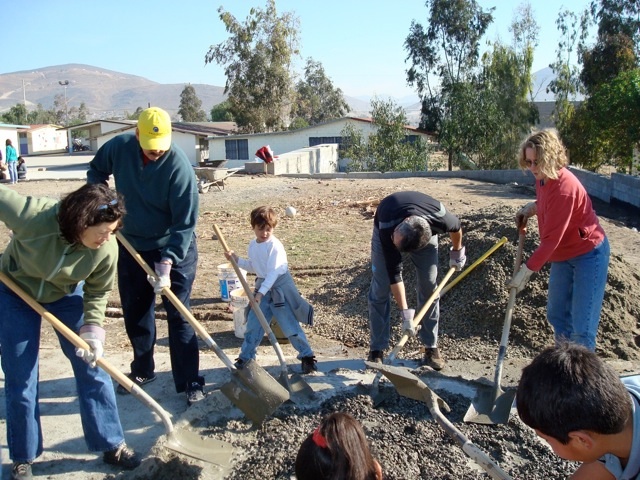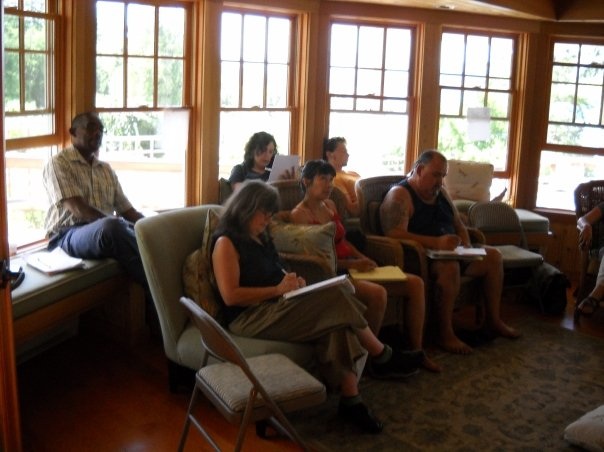Evolving States and Stages of Consciousness
Venita Ramirez, Geoff Fitch and Terri O’Fallon
How do people develop? What do the later stages of consciousness look like? Are there methods and practices we can employ to facilitate the process? Robert Kegan (1994), Suzanne Cook-Greuter (2002) and others have contributed a great deal to the field of adult development in recent years. Still, we have much more to learn. For example, until now, we haven’t really known what it takes to help people move from one stage to another.
Few people have understood in practice the difference or the relationship between state and stage development. Few universities offer courses in adult ego development even in the departments of education and psychology. We’ve had even less data on individuals at the latest stages of
development. Furthermore, much of the research has taken place through studying written assessments, without observing actual people in real time. And some people even question whether or why we would want to help people develop in the first place. Thankfully, Suzanne Cook-Greuter (2002) has contributed years of study and a wealth of knowledge about post-conventional stages of individual development.
Terri O’Fallon, one of the principals of Pacific Integral, with more than forty years in education, is continuing to research the nuances of the very latest states and stages of consciousness. In the past 6 years, we have coupled the use of inter-rated Maturity Assessment Profiles (MAP) with our direct observations, face to face with individuals in our Generating Transformative Change (GTC) program at Pacific Integral. We are learning how in-the-flesh individuals interact, behave, think and develop at these later stages. In fact, we are fascinated by what is occurring and as a result, we are encouraged about what is possible for humanity.
Since 2006 our GTC participants have taken the Maturity Assessment Profile (MAP) prior to beginning our GTC program and again two years later. Each MAP is scored by two, separately, trained scorers to verify accuracy. The GTC program is 9-15 months in length, consists of 4-6 four-day retreats, on-line learning, and application projects in the months between retreats. So far we have results back on four cohorts (about 50 people). In addition we have or are working with another three cohorts in which we are observing real time development that clearly seems to be following a series of patterns and behavior changes, some of which Terri describes in the theory paper she presented at last year’s Integral Theory Conference. Along with our participants, we seem to be learning what it is that helps individuals open to greater awareness, happiness, spontaneity, universal care and the capacity to respond to the increasing complexity of life and evolutionary systems on our planet as they present themselves in each moment. We seem to be learning what helps people develop through the stages. Statistical results can be found on our website in a paper entitled: Enacting Containers for Integral Transformative Development.
What is it that allows for transformation? Much of the answer to this question remains a mystery, for we realize that our small sample are self-selected individuals who already have a keen propensity for growth and have mostly out-grown other paths and practices they have followed. Some of them have meditated for many years. Others come in as seasoned therapists, physicians, or international business executives who have extensive training in human development, psychology and leadership. They are looking for deep, lasting, integral transformation—an integration of all they have known and a bridge to the evolutionary change that seems to be sweeping the planet. Many more people in the world never move beyond the norms of their social conditioning. And perhaps this leads us to the first basic element that seems to support development among our participants: They have found a place and a community where, over an extended period of time, they can be more fully themselves than they ever have before.
Preparing the Ground for Transformation
1. Welcoming Authenticity and Complexity through a Collective Field of Support and Reflection
One of the primary conditions that seems to spur individual and collective transformation is extended engagement with a group of people where at least some of the members are operating at later stages of development, and all of the members have an open intention to learn from one another. These later stages exert a pull on the group’s collective consciousness, facilitating a naturally occurring subtle osmosis on the individuals as well as on the whole. In addition, the group field must provide a kind of containment or safety that invites trust, depth, intimacy and authenticity. As this trust and safety develop, individuals and the group as a whole begin to risk even greater authenticity and then begin to step outside of the self-identified bounds they had assumed were firmly established. In fact many of our participants become aware of possibilities within them that they hadn’t even realized were there as they begin to take risks that are social, emotional, behavioral, verbal and systemic within their group. These new ways of being, thinking and acting occur both in the group and then as active experiments between retreats. In conventional circles, these same behaviors are often seen as crazy, ridiculous, arrogant, unreasonable, too complex, unrealistic, impractical or in un-resolvable conflict with another part of one’s life. As a result most people are held back by the conventions and norms in their everyday lives.
These days, it is not difficult to find individuals in the world who hold post-modern views. However, for those individuals who develop beyond the post-modern stage, it becomes increasingly more difficult to express ones self and find others with whom to create and collaborate even further. These later stage individuals often are misinterpreted, ostracized and lack social support for their ideas and contributions. We perceive that this marginalization impedes our human evolution and development as a human family. In GTC, we tend to remove this cultural cap. Individuals feel free to express their interior views, collaborate over time with others, and take concrete steps toward implementing their dreams. The collective intelligence of an entire group of individuals is unleashed. A shared heart and a shared consciousness begin to emerge. At the same time, concrete, subtle and projective feedback and honesty are encouraged which supports the development of relationships that are truthful, real, genuine, humble, mutually nourishing, engaging and stimulating. We believe that communities of practice in which people feel safe and are encouraged to risk and express their greater levels of care, complexity and innovative ideas are imperative for individual and collective development.
2. Witnessing and releasing the subtle ego: Questioning the concept of self
Another element that seems to be key in helping individuals develop and transform is to help them see how their own individual and collective interior processes and exterior behavior, interact in the moment. In our program, we work with witnessing our awareness of the concrete, the subtle, pressing into the causal. We remind our participants to be aware of their breathing, the sensations and feelings in their bodies, their thoughts, their habitual assumptions and interpretations and patterns. We ask them to be aware of their exterior body and behavior as well as the behavior and response of others in the room. We ask them to be aware their relating with one another in the gross, subtle and causal realms. And if they don’t understand what we mean by gross, subtle and causal, we help them learn through embodied experience. All of this is done in the moment, in actual practice during our retreats. It is much more than a mental exercise. Our in the moment witnessing and reflecting of one another, bring the individuals and the whole into greater alignment, coherence and presence.
In addition to tending to what is happening on an individual level, we ask participants to become aware of the collective consciousness and relational field, as well as group norms, behavior and interpenetrating systems. We invite them to disrupt the autopoietic nature of their habitual system and encourage them and us to help each other notice when we get stuck in unquestioned group norms and assumptions. As 12-15 individuals begin to operate within this reflecting awareness, there is an exponential affect with resulting expansion, depth and aliveness throughout the consciousness of each individual, the collective, and the systems in their lives back home. Out of the submersion in this visceral experience and from the opening to one’s own awareness and aliveness, come a natural revelation of the fluid nature of the self and reality. Together individuals begin to question assumptions about everything they’ve come to believe and think they know. When one can drop identification with ones own habitual perspective and become aware of the whole, surrendering even that to a felt sense of the ineffable, together, the boundaries of me and mine slip away and I become one of many who are worthy of service and attention.
These revelations open the mind further in ways that continue to stimulate the ongoing, longitudinal process of transformation.
3. Developmental Inquiry
Beyond an environment of authenticity and awareness, GTC brings a very specific form of inquiry and presencing that arises out of our collective understanding and embodiment of the stages. We frame and sustain an inquiry that reveals and makes object the developmental structures as we practice in real time. For example, rather than only being aware of thoughts, sensations, and emotions, we also call awareness to their structure. This starts with seeing their structure as distinct from the content of their actions, which helps us avoid the pitfall of more intellectual exploration of integral territories. It is through revealing and exploring the structures of self—our motivations, patterns of interpretation, and so on—that we allow our action logic to loosen from it’s moorings and evolve.
We also appreciatively presence the emergent structures with individuals and collectives as we hold and guide participants in the program. While a longer description of this subtle, paradoxical process is beyond the scope of this article, it is important to note that in the presence of emerging structures in individuals and collectives, we take those structures to be real as an embodied wholehearted reality and with the willingness and readiness of the participants those intentions support transformation.
4. Conceptual Information
Another significant aspect of the transformational process is the provision of a conceptual framework to support the process. Overemphasis on theory impedes embodied learning; without enough theory, individuals become lost, unable to understand or navigate through the process or unable to articulate what they are learning. In the GTC program, we base much of our conceptual framework on Integral Theory. As described above, we bring awareness to the inside and outside of the individual and collective at the concrete, subtle and causal levels. Conceptually and experientially we teach the four quadrants and the eight indigenous methods. We work with systems, polarities, Holacracy, Theory U and shadow in individuals and groups. We work with the relational aspects in individuals and the group. And we work explicitly with state and stage development. We’ve found that those who have a propensity toward spiritual practices of devotion and love tend to fare better as they develop toward the causal floor at Construct Aware and later (O’Fallon 2010). So we encourage an opening of the heart and cultivation of practices that include love and service. At later stages, as the heart opens, complexity seems to have more room to reside and relax. When the heart is guarded, clear seeing is impossible. Conversely, when the mind and intellect are not engaged, complexity has no place to function. We encourage the development of the whole person in body, mind, heart, spirit, shadow and action in the world.
5. Living Life as an Evolving Impulse to Love
With support, individuals are invited and encouraged to take their learning into their personal and work environments and begin expanding themselves in those areas. It is one thing to learn to be authentic, intimate, trusting, nuanced and aware in a small group, and yet another to take this complexity of thinking and being into the world. After all, we’ve already pointed to society’s marginalization of those who offer ideas and visions sourced from deeper understanding and greater complexity. Here is where the release of one’s ego is important, for to truly love and serve, we must understand the other’s perspective as much as possible and make room for it. We learn to integrate each other’s perspectives into a whole and then proceed with the next action step. The awareness practices described above, and conceptual knowledge, along with the confidence and encouragement that come from a supportive, evolving community, provide a firm foundation for each individual to expand the limits of their own expression into a wider embrace of universal care and complexity. The fertile ground of such a community enlivens each individual with passionate inspiration, deepens their ability to bond with each other and increases their capacity to see and intervene in the world whether locally or globally, from an evolving, aware, complex view of reality. This element of the transformational process grounds and roots the learning so it can take hold and evolve over the remainder of one’s life.
The Finer Points of Transformation
What helps people develop?
In summary, we see these elements as instrumental in facilitating transformation in individuals and systems: 1. A deep field of acceptance and encouragement to risk being fully themselves with others who can help raise the bar. 2. Reflecting awareness and practices from the eight indigenous perspectives and their combinations. 3. Developmental inquiry and understanding. 4. Conceptual frameworks that are held lightly as useful constructs. 5. Actual practice in the real world with ongoing support.
What does development look like at the later stages?
As mentioned earlier, Suzanne Cook-Greuter has contributed significantly to the field of adult development. In particular she has identified the characteristics of individuals at Construct Aware and Unitive, two levels beyond the integral or Strategist stage of development. Over these past five or six years in our GTC program, we have had the opportunity to observe individuals as they expand in ever increasing embrace and complexity. Together we observe and discuss similarities and patterns that we see in our participants. We’d like to share some of what we have observed in the individuals who have taken our programs over the last five years and share some examples of practices and support that can be provided at the later stages.
Strategist
Strategists are what spiral dynamics refers to as yellow and what Ken Wilber refers to as teal or integral. What we see in our participants whose test results are at the Strategists level is that they have a forward momentum. They tend to be active doers in the world who can see a larger view than those before them. Like Individualist/Green they can take a 4th person perspective and see contexts; however, they have moved beyond Individualist in that they can prioritize contexts. We see in our Strategist participants an ability to prioritize that helps them see what can be done to move things in a particular direction on a larger scale. They can see interlocking systems and realize that larger scale problems cannot be solved without addressing multiple systems simultaneously. The Strategist can get caught in their own view, plan of action or vision and think they are right about it. They cannot yet see or understand that their plan is just another construct that ultimately is empty of being right or wrong or having meaning.
Practices to help Strategists transform—Our strategist participants want to develop because they like to move forward and achieve (similar to Orange/Achiever), but paradoxically this desire to develop can sometimes freeze them where they are. One way we help Strategists is to help them see that their beliefs are constructs when there is a natural readiness for this. Another practice we offer Strategists is to ask them to see that whatever they judge or perceive as outside of themselves may also be true about themselves (the nature of projection). We also encourage them to witness in the moment, breathing and feeling into their bodies to connect with their feelings, heart and vulnerability; and when they are truly ready to move into construct aware, we encourage them to begin to consider letting themselves feel what it is like to let go into the unknown.
Construct Aware
As we observe our participants in the Construct Aware stage (Turquoise), we see individuals who are becoming aware of the constructed nature of reality. They are moving from the subtle floor where feelings, visions and dreams are taken to be solid, to a causal floor where everything concrete and subtle, including one’s own experience, is seen as an outcome of the constructing nature of the mind. As these constructs are penetrated, the person steps back further and further and sees there is nothing really solid on which to base any claim. Everything previously taken to be solid, is more empty and even inherently meaningless. For some, this experience is quite freeing, albeit disconcerting. For others, the experience can be filled with angst, for everything is meaningless. Emptiness can be lonely. It is here that unless one has had a strong practice of love, the person may become cynical, deconstructing everything. At this point the individual is not able to prioritize the constructs they are experiencing. Everything is deconstructed and there is no place to go. Strategists often accuse people at this level of being green, not realizing that if they themselves continue to develop they will soon be in this very same place.
Practices to help Individuals at Early Construct Aware transform—We support our construct aware participants unfolding just as they are for as long as it takes. This is a major shift and can take some time to integrate. Some are able to enjoy this time and be loving in it. If they are depressed, anxious or lonely we again work with them on breathing into their bodies, to integrate body and emotion with the emptiness of mind. We give them devotional practices of love, such as tonglen, or feeling what it feels like to be in the body of another (empathy). Sooner or later people at this stage become acclimated to the play of emptiness and deconstruction or with having no direction, and they naturally move to the next stage, sometime aided with a growing impulse to create, express, and contribute.
Late Construct Aware
At some point a person moves beyond the emptiness and deconstruction as the primary experience. Either naturally, or perhaps out of necessity they is moved to put things back together and move on with their life. It is here that we observe participants allowing the revelation of a brand new combination of constructs to come together in their minds, piecing together forms that have never been combined before, into an original and complex system for the benefit of society. We see that a person at this stage has seen the constructed nature of their own personal identity, including the limiting perspectives of the ego, and therefore, tends to exhibit less rigidity and arrogance than Strategist. At late Construct Aware, the individual moves once again into an active phase in which they are taking a newly constructed framework into the world.
Practices to help late Construct Aware transform—These individuals long to be held, seen and recognized in their abilities to take things apart and put them together in infinite ways. So we allow the fruition of the incredible capacity this stage has to develop complex maps of their constructions as a personal expression of the impulse to impact the world, while helping them encounter and work through the inevitable limits of the impact of these constructions and their ability to create shared meaning around them. We hold them with acceptance while showing them the possibility of integrating emptiness and form. It is this coming together of emptiness and form and the need for simplicity in their complexity in order to render their creations practical, that these individuals naturally move to the next stage.
Unitive
At Unitive individuals bring the emptiness and fullness together into an embrace of all of life and existence, from the micro to the macro, throughout time, space and emptiness. For Unitives the integration of emptiness and fullness is their lived experience. They have a deep love and compassion for all of humanity and sentience and they accept life is just as it is, both full and free. Through our work at Pacific Integral, we have supported several of these rare individuals.
This article offers a brief sketch of some of the ways we’ve seen individuals at later stages develop and some of the ways we’ve found to support that development.
How is development useful?
The idea of stage development in consciousness is fascinating to some and disturbing to others. Some argue that by focusing on “vertical” development, we lose touch with our authenticity, our humanity, the here and now of concrete experience, and loving embrace of what is. Unfortunately it doesn’t take vertical development to lose touch with humanity, authenticity and the here and now. Think about someone at varying levels of intelligence and influence who rationalizes their dishonesty, or someone who has never explored the deeper aspects of the self. We cannot blame development for our ills. It has been our experience that, in general, development tends to assist one in becoming more compassionate and more able to incorporate the needs of others in creating solutions. So why should we develop? It seems that no matter how good someone’s heart may be, if they can only see their own small world, whether egocentric, ethnocentric or even from a conventionally successful standpoint, then there is the likelihood of not seeing the whole. When individuals cannot see that their actions and behavior affect all of humanity well into the future, then we are more likely to continue living in a fragmented world in which corruption runs unchecked and life is a free for all. As individuals develop into later stages of awareness, they begin to take responsibility for our human existence, not just for their own life, but for all of life. They are more able to let go of opposition, entanglement, fear, and limiting beliefs, surrendering their own view to a more collaborative approach, across constructed boundaries. From our experience, as people develop, they tend to see more of what is possible. They create collaboratively, as an emergent, spontaneous, response to whatever is happening in the moment, with a view to personal, local and global issues, integrating wisdom from the past with innovation that supports a more humane future. For this reason, we are strong advocates for development that occurs with support in a natural unfolding; the kind that integrates universal care, wisdom and increased awareness in service to a more beautiful future for all.
Terri O’Fallon, Ph.D. has taught, consulted and led in the field of learning and change in human systems for nearly 46 years. She is a certified scorer of the Leadership Development Framework, a founder of Pacific Integral and a founder of the Developmental Research Institute. Her specialty is in the developmental trajectory and span of human systems of all kinds. She has a Ph.D. in Integral Studies.
Geoff Fitch is an integral coach, consultant, teacher and founder of Pacific Integral. Geoff works with visionary individuals and organizations, bringing deep insight and innovative approaches to catalyze higher-order capacities needed for the complexity of our emerging world. His work synthesizes decades of experience in organizational practice, spiritual and psychological growth, social change, and integral theory and its application.
Venita Ramirez is a partner at Pacific Integral and holds a Master of Arts degree in Psychology. She has twenty-five years experience coaching and counseling individuals in private practice; integrating body-centered psychotherapy, integral theory and consciousness. She teaches in the Transpersonal Psychology program at Antioch University in Seattle, and collaborates with individuals worldwide who are interested in large-scale change.
For more information on Pacific Integral and the Generating Transformative Change program, contact us at gtc@pacificintegral.com, or visit www.pacificintegral.com.








Pingback: March 2011 Table of Contents
Pingback: Notes from the Field
what an outstandingly clear and hopeful article
kudo’s squared
Thanks for this! So rare to see an article that actually explores the outer and most inclusive reaches of consciousness…
I may be in touch with you soon — we’re on the same page! We have a community here in SF (AuthenticWorld) that is exactly as you describe — a Collective Field of Support and Reflection…
Looking forward to more!
– Bryan
Thanks, Bryan and Emik!
Be in touch anytime.
Blessings,
Geoff